Book contents
- Frontmatter
- Contents
- List of figures
- List of tables
- List of contributors
- Introduction: symbolic action in theory and practice: the cultural pragmatics of symbolic action
- 1 Cultural pragmatics: social performance between ritual and strategy
- 2 From the depths of despair: performance, counterperformance, and “September 11”
- 3 The cultural pragmatics of event-ness: the Clinton / Lewinsky affair
- 4 Social dramas, shipwrecks, and cockfights: conflict and complicity in social performance
- 5 Performing a “new” nation: the role of the TRC in South Africa
- 6 Performing opposition or, how social movements move
- 7 Politics as theatre: an alternative view of the rationalities of power
- 8 Symbols in action: Willy Brandt's kneefall at the Warsaw Memorial
- 9 The promise of performance and the problem of order
- 10 Performance art
- 11 Performing the sacred: a Durkheimian perspective on the performative turn in the social sciences
- Index
- Cambridge Cultural Social Studies
- References
10 - Performance art
Published online by Cambridge University Press: 07 December 2009
- Frontmatter
- Contents
- List of figures
- List of tables
- List of contributors
- Introduction: symbolic action in theory and practice: the cultural pragmatics of symbolic action
- 1 Cultural pragmatics: social performance between ritual and strategy
- 2 From the depths of despair: performance, counterperformance, and “September 11”
- 3 The cultural pragmatics of event-ness: the Clinton / Lewinsky affair
- 4 Social dramas, shipwrecks, and cockfights: conflict and complicity in social performance
- 5 Performing a “new” nation: the role of the TRC in South Africa
- 6 Performing opposition or, how social movements move
- 7 Politics as theatre: an alternative view of the rationalities of power
- 8 Symbols in action: Willy Brandt's kneefall at the Warsaw Memorial
- 9 The promise of performance and the problem of order
- 10 Performance art
- 11 Performing the sacred: a Durkheimian perspective on the performative turn in the social sciences
- Index
- Cambridge Cultural Social Studies
- References
Summary
Introduction
“Performance art” is a collective term covering a range of artistic activities and movements, that, from the 1960s onwards, appeared in different domains such as the visual arts (Joseph Beuys, Christo, Gilbert and George, Rebecca Horn, Dan Graham, Bruce Naumann, Hermann Nitsch), dance (Pina Bausch), theatre (Robert Wilson, Richard Foreman, Richard Schechner, Peter Brooks, Vito Acconci, Antonin Artaud, Chris Burden), circus (Jerome Savary, the Performance Vaudevillians), music (John Cage, Philip Glass), and pop culture (Laurie Anderson, Yoko Ono). Most performance art resists the attempt at neat classification by reference to traditional branches of art and turns this crossing and fusing of boundaries into a distinctive feature. A range of programmatic statements and descriptive accounts of performance art is available (e.g. Lance Carlson 1990; RoseLee Goldberg 1988), but a systematic reconstruction is still missing. The following remarks attempt such a systematic outline of performance art rather than a historical reconstruction of its development.
Although quite heterogeneous and manifold, the field of performance art might be demarcated by the following programmatic commitments:
(a) Performance art shifts the focus of artistic activity from the completion of an enduring piece (“the work”) to the volatile event of a corporeal performance. This move beyond text and picture towards eventness and corporeality is the most distinctive feature of performance art (Bruce Naumann, Chris Burden, Vito Acconci). It links many performances closer to theatre than to the visual arts. However, unlike traditional theatrical performances most performance art does not separate actor from stage director and script from performance. In many cases it tries to overcome the model of theatrical illusion and to return to the ritual roots of theatre (Schechner 1977; Artaud 1958).
[…]
- Type
- Chapter
- Information
- Social PerformanceSymbolic Action, Cultural Pragmatics, and Ritual, pp. 315 - 324Publisher: Cambridge University PressPrint publication year: 2006
References
- 2
- Cited by



